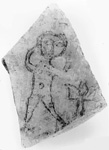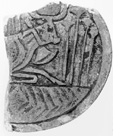Click on images below for enlargements and object descriptions.
Female Figures
 |
The nude woman reclining on a bed at left probably had several layers of
meaning involving fertility, sexuality, and religion. |
 |
The paddle doll at left, which terminates in a greatly enlarged pubic area,
probably served as a fertility figure. |
| The steatopygous woman at right, or woman with emphasized hips, buttocks,
breasts, and belly, was found in a granary so may symbolize fertility. |
 |
The image of a nude woman at right is one of the few surviving ostraca (potsherds) from the Graeco-Roman period
with human figures. |
 |
 |
The seated "orant" (with arms upraised in prayer) at left, found
in a domestic context, may have been intended to promote domestic fertility. |
 |
The standing figure at left is typical of later "orants," vividly
painted and highly stylized. |
| The pose and emphasis on sexual characteristics of the reclining figure
at right suggest it symbolized both sexuality and fertility. |
 |
Painted on the panel fragment at right, the nude body of Isis-Aphrodite,
who is linked to love and sexuality, is visible through transparent drapery. |
 |
 |
The frog represented on the lamp at left is associated with the goddess
Heqet in ancient Egypt and symbolizes fertility. |
 |
The cow on the necklace counterpoise at left is associated with the goddess
Hathor, who was identified with music, dancing, and sexual pleasure. |
| The god Bes, depicted at right, is often represented on beds and protects
women in childbirth, associating him with women's sexuality and fertility. |
 |
At right Aphrodite exposes her nude body and the phallic god Priapus his
(now missing) erect penis--an image with religious, erotic and humorous
connotations. |
 |



![]()